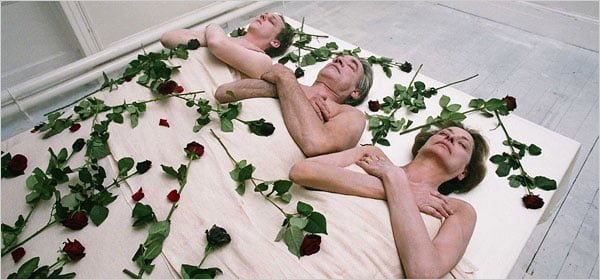The Living and the Dead DVD

Lord Donald Brocklebank (Roger Lloyd-Pack, "Vanity Fair," "Harry Potter and the Goblet of Fire") is destined to be the last of his illustrious line to inhabit his family's vast, multi-winged estate in the English countryside. With no funds, a desperately ill wife ensconced in an upstairs bedroom and a grown son, James (Leo Bill, "Vera Drake," "Becoming Jane"), whose schizophrenia is barely controlled by numerous drugs, Donald is at the end of his tether. When he must attend to business before Nurse Mary (Sarah Ball) can arrive to care for his wife Nancy (Kate Fahy), James tries to make daddy proud by taking over, but Donald will return to a house of "The Living and the Dead."
Laura's Review: B-
This award winning (Austin Fantastic Fest, Sitges New Visions) film from 2006 has just been released on DVD by TLA Releasing's Danger After Dark label. While not entirely successful, it is nonetheless a compelling film that defies categorization. "The Living and the Dead" certainly has elements of horror, as the plethora of knives and hypodermic needles point to, but this is a unique entry for those who like thought-provoking concepts served up with their grue. writer/director Simon Rumley was inspired to make this film after experiencing his mother's death from cancer, but "The Living and the Dead" is about more than loss and slow rot (which is visually evident in the abandoned Tottenham House used as the film's location). The film is an elegy to a dying breed, to helplessness and both literal (the house) and figurative (James's psychosis) isolation. We're introduced to the Brocklebanks in their rambling abode as Donald takes a telephone call from the old style corded black telephone in the home's entryway. James, suited and tied with marigold colored socks, strains out of his skin to be involved, his hands splayed stiffly from his sides. Donald treats James as an inconvenience, albeit with a sternly patient demeanor. One can feel the home's echoey chill and see the bunkered down manner in which the Brocklebanks inhabit their home only in part, not unlike the Torrances in the Overlook Hotel. The home's charmless kitchen is connected to the rest of the house via dark subterranean hallways, yet Donald reads his paper there, ever watchful that James has taken his multiple pills and injection. Nancy Brocklebank receives breakfast in bed in her upstairs room. There is clearly a loving relationship between her and Donald and a family photo of three is both hopeful and sad. But suddenly, Nancy finds herself alone with James, who is not only determined to supplant external help but to actually cure his mother. Nancy is warily encouraging at first, but things quickly spiral out of control. Rumley tells his story on four separate planes and while it is relatively easy to keep them separate it is not always evident how they connect into a linear story. A bookending device featuring Donald can be conjectured, but the flashback within the main flashback is confusing - is this what led to Nancy's flashback state or is this another of James's delusions or is it something else again? Settling on an answer creates more questions and suspension of disbelief. With four threads to tell his story, Rumley still leaves too many holes, requires too many leaps. There is no fault in the acting, however. Lloyd-Pack makes us feel the weight of his burden shouldered still with dignity and love for his wife. Fahy projects familial concern, warmth, and rising horror tempered by maternal instinct. Bill is absolutely believable as the mentally ill man-child. Technically, the film is first rate as well. Cinematographer Milton Kam uses the Lynchian fast speed head-shaking technique to present James's mental state and travels with him throughout the estate, including a literal downward spiral shot. Photo negative images of the home's Escher-like staircase flash against the positive and external night shots quickly dissolve into daytime. Richard Chester's original score switches between somber piano and music cut through with noise. Ultimately, Rumley's storytelling lapses frustrate, but his film maintains its grip throughout. Be forewarned that "The Living and the Dead" has moments that may make some flinch (although nowhere near as badly as I had expected), then take it as a good bet for those looking for something running from the mill. The DVD includes a fine making of piece that champions independent filmmaking, deleted scenes and the film's trailer.
Robin's Review: DNS
DNS

